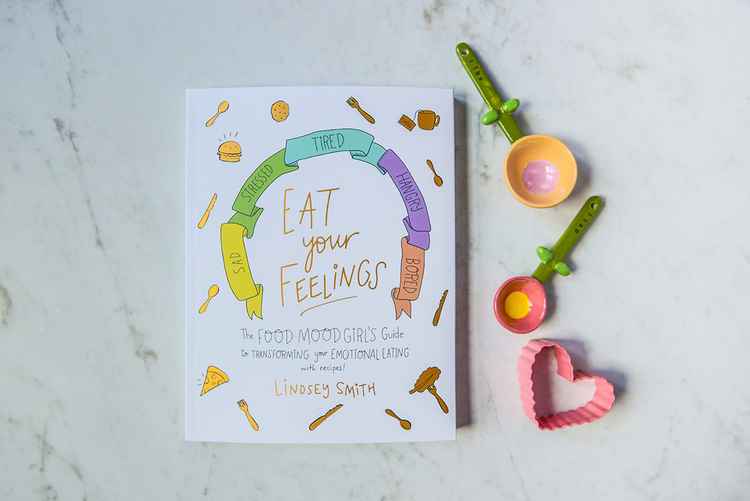Eat Your Feelings with Lindsey Smith

The Food Mood Girl on her latest book, and transforming your emotional relationship with food.

When health coach and author Lindsey Smith was 12 years old, she was hospitalized for severe anxiety. That’s when she told her parents that she needed to start seeing a therapist.
“Later they found out it was because of panic attacks that I had been having at school,” says Smith. “I was a very anxious kid; I was a perfectionist. After that experience, even though I was 12—I was intuitive I guess—I [knew] this wasn’t a way to live. I didn’t want to be in the hospital. I didn’t want to feel this anxious all the time.”
And while therapy helped, Smith knew she was still missing something. She decided she wanted to start working with a naturopath at the wellness clinic in her hometown.
“He really instilled in me the concept of mind, body, spirit. We started completely changing the way I was eating—that was the first thing that we did. And we focused on gratitude, self-love and moving my body.”
Smith began to see change within six months of working with the naturopath, and by the time she was in the sixth grade, she was cooking her own meals and taking them to school with her. In ninth grade, the once-shy Smith began teaching stress management workshops at conferences, and after graduating college with a bachelor’s in communication and completing a culinary program and courses at the Institute for Integrative Nutrition, she realized that her path was meant to help people.
“I thought back to my own struggles of anxiety, and how I really incorporated this kind of food and mood lifestyle,” she says. “And so in 2010, I developed [my blog] ‘Food Mood Girl’ because I wanted to help people that were suffering from similar things that I had gone through.”
Earlier this month, Smith released her third book and first cookbook, “Eat Your Feelings” (Wednesday Books, 2018). “Junk Foods and Junk Moods” (Incredible Messages Press, 2012)—Smith’s “starter book”—told the story of overcoming anxiety and what she learned along the way. Her second book, “Food Guilt No More” (Tell Me Press; 1 edition 2015), talks about the guilt we carry around food, and how that plays into our food choices. So when her dedicated readership asked for recipes, specifically which foods help with certain moods, Smith’s idea for a third book was born.
“Eat Your Feelings,” Smith notes, is the only cookbook broken down by emotion, not by diet (keto, vegan, Palo, gluten-free). And while the recipes in her book can certainly appeal to those different types of lifestyles, it’s about understanding the end goal: People want to feel good, mentally and physically.
“I wanted to do it in a way that fits the food mood lifestyle I preach, which is not dieting, not deprivation, but what’s going to make you feel good,” she says. “There’s a [biological] reason why our body craves pizza when we’re sad, or when we’re stressed. So how could I bring some of the science, but also make it really fun? I kind of think of it as WebMD meets BuzzFeed.”
Taking back emotional eating
For Smith, it’s impossible to separate emotions and eating. “The whole point of ‘Eat Your Feelings’ is to take back emotional eating,” Smith says. “Food is emotional. When we were babies, we cried when we were hungry. That’s an emotional response to food. And in some ways, we’re very similar [as adults].”
The health coach believes that food—even healthy food—should be more than just fuel. It should be pleasurable. The problem, she notes, is that we’ve separated certain foods into categories.
“We’ve gotten into thinking of certain foods as the pleasurable ones. What if we learn to find pleasure in eating a kale salad? What’s it going to take for you to make it feel really good? You shouldn’t just want to eat something because you are like, ‘Oh well, this is healthy, so I should have to eat it.’ It should be enjoyable.”
Scientifically, Smith notes, enjoying our food has a multitude of benefits, including how our body processes and absorbs nutrients. “When you enjoy it and you feel good about [what you eat], your body actually does digest it differently. You end up getting more nutrients from it, whether it’s a piece of kale or a cupcake. It sounds a little hokey, but it actually is biologically true.”
Why we crave what we crave
Smith says there are many different reasons why our bodies crave certain foods during certain moods. “A couple of years ago, I found myself really craving grilled cheese. I stopped and was like, ‘Well, why do I want it? Why am I craving this grilled cheese all of a sudden?’ And after processing it and thinking about it, I was able to figure out that I was really missing my dad, [who] died in 2012. When I was a kid, every Saturday when he got home from work in the afternoon, he would make me a grilled cheese and we would watch ‘Unsolved Mysteries’ together. So it wasn’t really the grilled cheese. The grilled cheese was a part of it, but I was really missing that time with my dad.”
In response to that craving, Smith says, “Either I make a grilled cheese and eat it, and really appreciate it, or I’ll make a healthier adapted version, or I’ll do something that honors my dad in a different way. A couple of months ago, I found ‘Unsolved Mysteries’ on Amazon Prime and decided to indulge in that instead, because it fulfilled me in a way that grilled cheese never would.”
Biologically speaking, your mood can also inform why you’re craving what you’re craving. Smith’s book breaks down what’s happening to the body when we’re feeling sad, tired or hangry, and the foods that can help boost our mood.
For example, Smith says, if you’re feeling stressed or anxious, your body is on alert, so your body craves foods that are high in fat, sugar and salt—ingredients that can literally sustain you. “Fat can help your brain think, sugar gives you energy and salt has minerals that your body needs. So when you’re feeling stressed, it makes sense that that’s what your body craves,” she says.
But, Smith notes, we typically reach for the pizza or ice cream—foods that give us that quick fix: “If we can understand the biological standpoint of it … what if instead of the pizza, I have some avocado toast and with sea salt? There’s the healthy fat, you get the minerals from the salt, and that is going to treat your body better at long term than the quick fix.”
Mood-boosting foods
When eating to boost mood, Smith advises not only eating whole foods (fruit, vegetables, nuts, and so on) for the minerals and vitamins they contain, but also choosing those with certain properties. For example, when you’re stressed, reach for foods high in magnesium and low to the ground to snack on or add to your dinner recipe. “Grounding foods, like sweet potatoes or carrots, are low to the ground. They’re literally rooted, and so they can physically help you feel rooted and more calm and less stressed.”
She also outlines other items in her book that she calls “the mood-boosting extras”—such as raw cacao (in her brownie recipe) because “it hasn’t been stripped of the nutrients like regular cocoa,” and spices like turmeric, ginger or mushroom powder.
Indulge smarter
Of course, at the end of the day, Smith says, sometimes it’s OK to indulge in that double-chocolate brownie. But how do we learn to indulge thoughtfully—knowing when to give into our cravings, and when to reach for the healthier version? Here are four things Smith practices.
Mindful eating
“Something that I [try] do whenever I want to indulge is say to myself, ‘You know what? I’m going to eat this and I’m going to really enjoy it,’ and I think about the process of it getting to me. Especially if it’s a local bakery or something. Someone here made this, they created this recipe, they cared so much about and they were really inspired … I like to think about the process that it takes to get to my plate, and feel gratitude for the entire process.”
Train your brain with the healthier stuff
“One of the problems with transitioning to a food-and-mood lifestyle is that we’ve been tricked by our taste buds over the years to like certain things. So, of course, Doritos are not going to taste the same as [healthier] bean chips, because we’re so used to having the chips that have additives that change our brain receptors and make us crave Doritos. [So] indulge. But maybe the next week, try the healthier option, so that you can start getting your palate and your taste buds to change and transform with you over time.”
Listen to your body
Smith says asking our bodies questions is the number-one way that we can figure out what’s going to work for us and unlock clues to our cravings and who we are as individuals. “The more that you’re aware, then obviously you’ll know if it’s an emotional craving.” She says you’ll be able to acknowledge “this is a day where I’m eating that fudge brownie, and I’m going to enjoy every last bit of it.” Or, she says, “This is a day where I watch “Unsolved Mysteries” all afternoon, and don’t look at my cellphone.”
Self-love matters
Smith says, “You can eat as much kale as you possibly can—you can eat as healthy as you want. But if you’re just not feeling good about who you are as a person, it’s not going to matter. There’s no amount of healthy food in the world that can help you overcome that feeling. I believe self-love is definitely a key ingredient to all this. [Your body] is a magical machine and it’s literally fighting for your life every single day. I think that you should treat your body the best that you can, and realize how much it does care about you. And that’s why I think food should be enjoyed, and we shouldn’t feel guilty about it. Because that’s all a part, to me, of truly honoring yourself and your body, and of truly loving yourself.”
Photo credit: Quelcy Kogel; courtesy of Lindsey Smith